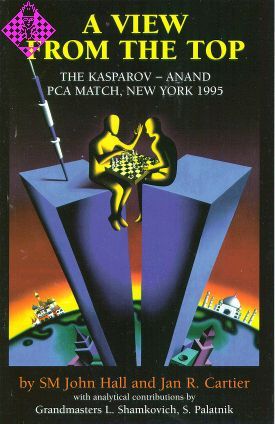Article Number
LXHALAVFTT
Author
A view from the top - The Kasparov - Anand PCA Mat
123 pages, paperback, Hays, 1996
Discontinued
| EAN | 1880673126 |
|---|---|
| Weight | 190 g |
| Manufacturer | Hays |
| Width | 14 cm |
| Height | 21.6 cm |
| Medium | Book |
| Year of Publication | 1996 |
| Author | John HallJan R. Cartier |
| Language | English |
| ISBN-10 | 1880673126 |
| Pages | 123 |
| Binding | paperback |
| Name | Hays |
|---|
EXCERPT:
GAME ONE
Anand - Kasparov
Sicilian Defense, Najdorf
New York, 1995
This game shows how Black achieves excellent coordination between his pieces in the Scheveningen Variation of the Sicilian. Especially interesting is the odyssey of Black's QB: from c8 to d7, back to c8, and finally to b7. The main point of this maneuver is to pressure White's center, especially the e4-pawn.
1.e4 c5 2.Nf3 d6 3.d4 cxd4 4.Nxd4 Nf6 5.Nc3 a6
Kasparov shows his willingness to enter the Najdorf Variation. However, he typically uses this move order to transpose into the Scheveningen Variation while avoiding the Keres Attack. For example, after the "traditional" Scheveningen move-order 1.e4 c5 2.Nf3 e6 3.d4 cxd4 4.Nxd4 Nf6 5.Nc3 d6 White can play Keres' sharp 6.g4!?. But by adopting the Najdorf move-order, 6.g4 is obviously impossible. Of course, using this move sequence carries the "risk" that the opponent will not permit the Scheveningen, instead forcing play into a main line of the Najdorf or Rauzer after 6.Bg5.
6.Be2
Taking up the Najdorf by 6.Bg5 is possible, but then one must be willing to face the super-sharp retort 6...Qb6, a line which Kasparov has played more than once. After 6.Be2, Black can still stay with the Najdorf by playing 6...e5, but Kasparov has long held a preference for the Scheveningen method.
6...e6
Forming the central pawn-wall characteristic of many variations of the Sicilian and particularly the Scheveningen. This dynamic duo controly a wide swath of important squares from c5 to f5; its message is clear - the White pieces are to be kept at bay. Meanwhile Black will be constantly viligant for a later opportunity to strike in the center by ...d5 and/or ...e5. This possibility of a strike in the center is an important means of hindering - or at least slowing down - White's most usual plan in Sicilian positions - an attack against the Black Kingside. [...]
GAME ONE
Anand - Kasparov
Sicilian Defense, Najdorf
New York, 1995
This game shows how Black achieves excellent coordination between his pieces in the Scheveningen Variation of the Sicilian. Especially interesting is the odyssey of Black's QB: from c8 to d7, back to c8, and finally to b7. The main point of this maneuver is to pressure White's center, especially the e4-pawn.
1.e4 c5 2.Nf3 d6 3.d4 cxd4 4.Nxd4 Nf6 5.Nc3 a6
Kasparov shows his willingness to enter the Najdorf Variation. However, he typically uses this move order to transpose into the Scheveningen Variation while avoiding the Keres Attack. For example, after the "traditional" Scheveningen move-order 1.e4 c5 2.Nf3 e6 3.d4 cxd4 4.Nxd4 Nf6 5.Nc3 d6 White can play Keres' sharp 6.g4!?. But by adopting the Najdorf move-order, 6.g4 is obviously impossible. Of course, using this move sequence carries the "risk" that the opponent will not permit the Scheveningen, instead forcing play into a main line of the Najdorf or Rauzer after 6.Bg5.
6.Be2
Taking up the Najdorf by 6.Bg5 is possible, but then one must be willing to face the super-sharp retort 6...Qb6, a line which Kasparov has played more than once. After 6.Be2, Black can still stay with the Najdorf by playing 6...e5, but Kasparov has long held a preference for the Scheveningen method.
6...e6
Forming the central pawn-wall characteristic of many variations of the Sicilian and particularly the Scheveningen. This dynamic duo controly a wide swath of important squares from c5 to f5; its message is clear - the White pieces are to be kept at bay. Meanwhile Black will be constantly viligant for a later opportunity to strike in the center by ...d5 and/or ...e5. This possibility of a strike in the center is an important means of hindering - or at least slowing down - White's most usual plan in Sicilian positions - an attack against the Black Kingside. [...]

